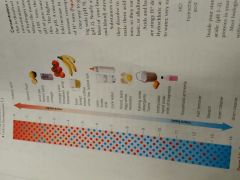![]()
![]()
![]()
Use LEFT and RIGHT arrow keys to navigate between flashcards;
Use UP and DOWN arrow keys to flip the card;
H to show hint;
A reads text to speech;
39 Cards in this Set
- Front
- Back
- 3rd side (hint)
|
Atoms |
Consist of protons, neutrons, and electrons |
|
|
|
Protons |
Positively charged subatomic particle that occurs in the nucleus of all atoms |
|
|
|
Electrons |
Negatively charged subatomic particle that occupies orbitals around an atomic nucleus. |
|
|
|
Neutrons |
Uncharged subatomic particle in the nucleus |
|
|
|
Charge |
Electrical property. Opposite charges attract and like charges repel |
|
|
|
Atomic number |
Number of protons in the atomic nucleus; determines the element |
|
|
|
Elements |
Pure substances that contain only atoms with the same number of protons |
|
|
|
Periodic table |
Tabular arrangements of the known elements by atomic number |
|
|
|
Isotopes |
Atoms of an element that differ in their number of neutrons; all elements have isotopes |
|
|
|
Mass number |
Total number is protons and neutrons in the nucleus of an atom |
|
|
|
Radioisotope |
Isotope with an unstable nucleus; decays at a constant rate into certain products |
|
|
|
Radioactive decay |
Process by which an isotope emit energy and/or subatomic particle when their nucleus spontaneously disintigrates; example: carbon 14's (6 protons 8 neutrons) neutron splits into a proton and electron causing it to become nitrogen 14 (7 protons, 7 neutrons) |
|
|
|
Tracer |
Any molecule with a detectable substance attached |
|
|
|
Shell Models |
Model of an electron distribution in an atom. Multilayered; electrons at the higher levels have more energy. Electrons can move to higher levels if an energy input gives it a boost, but immediately emits it's extra energy and moves back down |
|
|
|
Electron vacancy |
Vacancy in a shell. Atoms with vacancies tend to interact with atoms: they give up, acquire or share electrons until they have no vacancies in their outermost shell. Atoms are at their most stable state when it has no vacancies |
|
|
|
Ion |
Charged atom; positive charge when it loses an electron, negative charge when it pulls an electron away from another atom. |
|
|
|
Electronegativity |
Measure of an atoms ability to pull electons away from other atoms; not the same as a charge but depends on its size and how many vacancies it has |
|
|
|
Molecule |
Result of a chemical bond between two or more atoms with same or different elements |
|
|
|
Compounds |
Molecules that consist of two or more different elements |
|
|
|
Mixture |
Intermingling of two or more types of molecules/substance; No chemical bonds |
|
|
|
Chemical bond |
Attractive force that arises between two atoms when their electrons interact |
|
|
|
Solution |
Liquid mixture |
|
|
|
Ionic bond |
Strong mutual attraction of opposite charged ions |
|
|
|
Covalent bond |
Two atoms that share a pair of electrons: when sharing is equal, the bond is nonpolar, when one atom is exerting a greater pull, it's is polar |
|
|
|
Hydrogen bond |
Weak attraction between a covalent bonded hydrogen atom and another atom taking part in a separate polar covalent bond |
|
|
|
Solvent |
A substance, usually a liquid, that can dissolve other substances |
|
|
|
Solute |
Dissolved substance |
|
|
|
Salt |
Compound that dissolves easily in water and releases ions other than H+ and OH- when it does |
|
|
|
Hydrophilic |
A substance that dissolves easily in water, polar molecules because hydrogen bonds form between them and water molecules, pulling it's atoms apart; ex. Salt |
|
|
|
Hydrophobic |
A substance that resists dissolving in water; ex. Oil |
|
|
|
Polarity |
Any separation of charge into distinct positive and negative regions |
|
|
|
Cohesion |
Water molecules resist separating from one another |
|
|
|
Evaporation |
Transition of liquid to gas; resisted by hydrogen bonds |
|
|
|
Temperature |
Measure of molecular motion |
|
|
|
Concentration |
The amount of a particular solute that is dissolved in a given volume of fluid |
|
|
|
pH |
Measure of number of hydrogen ions in a fluid; H+ hydrogen = OH- hydroxide pH level is 7; the higher the number of hydrogen ions, the lower the pH level. Decrease in one-unit = tenfold increase of hydrogen ions: 0 = more acidic 14 = more basic |

|
|
|
Acids |
Give up hydrogen ions when dissolved in water |
|
|
|
Bases |
Substance that accepts hydrogen ions in water |
|
|
|
Buffer |
Set of chemicals that can keep the pH of a solution table by alternately donating and accepting ions that contribute to pH; ex. Base added to a buffered fluid causes the buffer to release H+ forming water which has no effect on pH |
|

